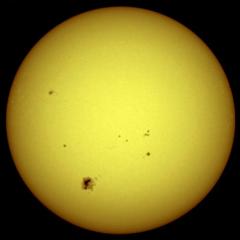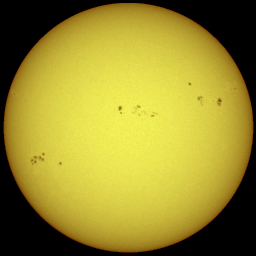 |
|
+ Home | ||

|
||||
| + Solar Cycle Prediction | + Magnetograph | + The Sun in Time | + The Hinode Mission | + The STEREO Mission |
The Photosphere
|
The photosphere is the visible surface of the Sun that we are most familiar with. Since the Sun is a ball of gas, this is not a solid surface but is actually a layer about 100 km thick (very, very, thin compared to the 700,000 km radius of the Sun). When we look at the center of the disk of the Sun we look straight in and see somewhat hotter and brighter regions. When we look at the limb, or edge, of the solar disk we see light that has taken a slanting path through this layer and we only see through the upper, cooler and dimmer regions. This explains the "limb darkening" that appears as a darkening of the solar disk near the limb. | ||
|
A number of features can be observed in the photosphere with a simple telescope (along with a good filter to reduce the intensity of sunlight to safely observable levels). These features include the dark sunspots, the bright faculae, and granules. We can also measure the flow of material in the photosphere using the Doppler effect. These measurements reveal additional features such as supergranules as well as large scale flows and a pattern of waves and oscillations. | |||
|
The Sun rotates on its axis once in about 27 days. This rotation was first detected by observing the motion of sunspots in the photosphere. The Sun's rotation axis is tilted by about 7.15 degrees from the axis of the Earth's orbit so we see more of the Sun's north pole in September of each year and more of its south pole in March. Since the Sun is a ball of gas it does not have to rotate rigidly like the solid planets and moons do. In fact, the Sun's equatorial regions rotate faster (taking about 24 days) than the polar regions (which rotate once in more than 30 days). The source of this "differential rotation" is an area of current research in solar astronomy. | ||
|
A 4.3 Mb MPEG movie showing magnetic features in the photosphere over a 36 day period is available here. These data were obtained with the GONG solar telescope network. The movie illustrates the rotation of the Sun as well as the evolution of the Sun's magnetic features - including sunspots. | |||
|
||||||||||||||||||||||||

